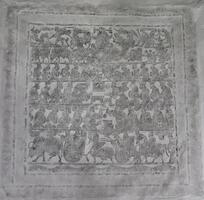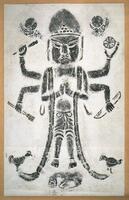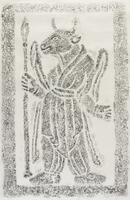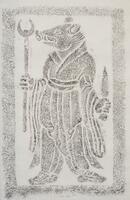14 UMMA Objects
14 UMMA Objects

Bo Yang
Rubbing of Journey of the Soul to the Paradise of the Queen Mother of the West (2000/2.1) - Front
2008
Museum purchase made possible by the Katherine Tuck Enrichment Fund
2008/1.154.1
Korean (Korean (culture or style))
Twelve Zodiac Animals: Sheep
1945 – 1980
Transfer from the Department of the History of Art, Slide and Photograph Collection, gift of Mrs. Pilsoon L. Chun
2021/1.128.8

Japanese (Japanese (culture or style))
Bodhisattva Amoghapasa (Japanese, Fûkûkenjaku Kannon)(Avalokitesvara of the never-empty noose)
1945 – 1955
Gift of Mrs. Caroline J. Plumer
1991/1.76

Korean (Korean (culture or style))
Twelve Zodiac Animals: Snake
1945 – 1980
Transfer from the Department of the History of Art, Slide and Photograph Collection, gift of Mrs. Pilsoon L. Chun
2021/1.128.6
Korean (Korean (culture or style))
Twelve Zodiac Animals: Rooster
1945 – 1980
Transfer from the Department of the History of Art, Slide and Photograph Collection, gift of Mrs. Pilsoon L. Chun
2021/1.128.10

Korean (Korean (culture or style))
Twelve Zodiac Animals: Ox
1945 – 1980
Transfer from the Department of the History of Art, Slide and Photograph Collection, gift of Mrs. Pilsoon L. Chun
2021/1.128.2
Korean (Korean (culture or style))
Twelve Zodiac Animals: Horse
1945 – 1980
Transfer from the Department of the History of Art, Slide and Photograph Collection, gift of Mrs. Pilsoon L. Chun
2021/1.128.7

Korean (Korean (culture or style))
Twelve Zodiac Animals: Dragon
1945 – 1980
Transfer from the Department of the History of Art, Slide and Photograph Collection, gift of Mrs. Pilsoon L. Chun
2021/1.128.5
Korean (Korean (culture or style))
Twelve Zodiac Animals: Rat
1945 – 1980
Transfer from the Department of the History of Art, Slide and Photograph Collection, gift of Mrs. Pilsoon L. Chun
2021/1.128.1

Korean (Korean (culture or style))
Twelve Zodiac Animals: Rabbit
1945 – 1980
Transfer from the Department of the History of Art, Slide and Photograph Collection, gift of Mrs. Pilsoon L. Chun
2021/1.128.4
Korean (Korean (culture or style))
Twelve Zodiac Animals: Dog
1945 – 1980
Transfer from the Department of the History of Art, Slide and Photograph Collection, gift of Mrs. Pilsoon L. Chun
2021/1.128.11

Korean (Korean (culture or style))
Twelve Zodiac Animals: Pig
1945 – 1980
Transfer from the Department of the History of Art, Slide and Photograph Collection, gift of Mrs. Pilsoon L. Chun
2021/1.128.12
Loading…
